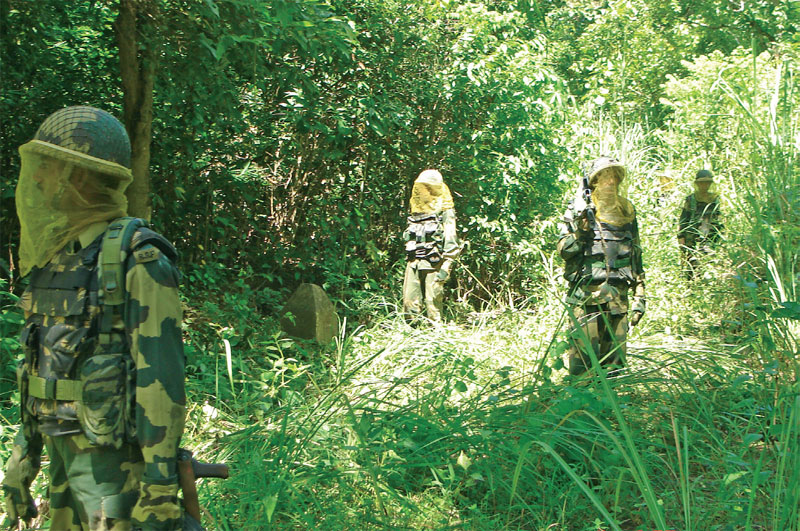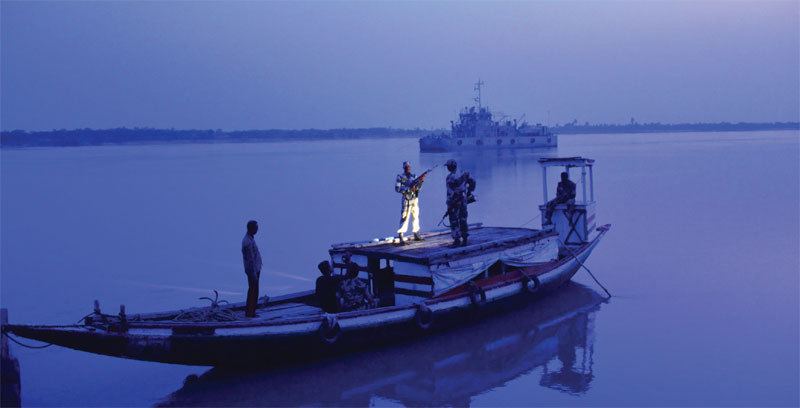Cattle trade with Bangladesh will earn goodwill, check smuggling and curb border violence
 S.K. Sood
S.K. Sood
I have had opportunity to attend several Inspector General and Director General Level Border Conferences in India and Bangladesh while commanding the North Bengal frontier of the Border Security Force (BSF) for over three years. The press in Bangladesh invariably alleged violence by the BSF against whom they referred as cattle traders.
The response by one of the Directors General—the late U.K. Bansal—was firm and appropriate. He asked a counter question and wanted to know who were these cattle traders the Bangladesh media was referring to, adding that there was no formal cattle trade between India and Bangladesh. According to Bansal, those who were attempting to smuggle cattle to Bangladesh from India were smugglers and trans-border criminals be they Indian or Bangladeshi nationals.
If those who were injured or killed were traders, why did they carry arms and attack BSF troops, he wished to know. He asserted that BSF troops who are tasked to patrol the border to prevent illegal activities used force, including opening fire, only to defend themselves against attacks by the cattle smugglers with sharp edged weapons and firearms. He concluded by saying that patrol commanders on the spot were well trained and responded only to an emerging operational situation and never used excessive force.
Bansal’s response brings out the dilemma before the BSF in preventing cattle smuggling to Bangladesh, which emanates from one of the mandated tasks of preventing smuggling. Indian cattle are in huge demand in Bangladesh because of better breed and larger yield of meat. The locally available cattle in Bangladesh are not adequate to meet the high demand for their beef and leather industry. This demand is met by smuggling of Indian cattle, mainly through riverine gaps in border fences and also by cutting the fence wherever it is beyond the observation of the BSF patrol even for a short period.

Both Indian and Bangladeshi nationals are involved in this illegal activity. The magnitude of cattle smuggled to Bangladesh can be gauged from the fact that a total of 5,65,141 cattle heads were seized by troops all along 4,096 km long India-Bangladesh border from 2014 to 2018. The quantum of cattle seizure has come down drastically in recent years, with 2,27,799 cattle heads being seized during the five-year-period from 2018 to 2022. The declining trend of cattle seizures also gives credence to the reported initiative of the Bangladesh government to encourage cattle rearing in Bangladesh itself in order to reduce the violence along the border and adverse impact to the government’s image.
The quantum of seizure of cattle may, however, not be the true indicator of actual numbers smuggled, which may be much larger. The cattle seized by the BSF, even though very little percentage of the total quantum smuggled are channelized back into smuggling because the same cartel buys them in auction from customs. As per a 2019 estimate, cattle smuggling to Bangladesh is estimated to be worth more than USD 500 million annually.
The well-connected cartels transport cattle to the Bangladesh border in huge numbers on a daily basis from as far as Rajasthan, Haryana and UP for smuggling without being stopped by any law enforcing agency enroute. Religion has no bar when carrying out this illegal activity. The lure of profit unites everyone, be they Hindu or Muslim or believers of any other religion. Neither the organisations advocating animal rights nor the police of states falling enroute take any action in the matter. Even if the transporter or the truck driver etc., are apprehended, it is on minor charges such as the pitiable conditions in which the cattle was being transported. Agencies do not investigate such cases deeply enough to reach the actual kingpin.
Preventing smuggling being a mandated task, it falls upon the shoulders of small BSF patrols comprising three to four personnel to guard a stretch of as much as 1.5 to 2 km. They are required to do this in the face of a host of armed smugglers who don’t hesitate to attack them, often causing serious injury and even death. Left with no alternative, the troops are compelled to use force to defend themselves and also to intercept the cattle and smugglers.
Forty-three deaths and 33 injuries to Bangladeshi criminals, 41 deaths and 26 injuries to Indian criminals besides, eight deaths and as many as 439 injuries to BSF personnel on the border during the six-year period from 2017 to 2022 point to the gravity of the situation. The causalities occur mainly during anti-cattle smuggling operations, mostly at night. No wonder the India-Bangladesh border has the dubious distinction of being dubbed the sixth most dangerous border in the world.
A large number of BSF personnel being killed or injured also contradicts the attempts by the Bangladesh media to dub the BSF as a trigger happy force. They continue to propagate that the BSF fires at the cattle smugglers (traders as the call them) without provocation.
Each death or injury to a Bangladeshi causes a virtual storm in the corridors of power in Bangladesh and has an adverse impact on the cordial relations between the two countries and between their border guarding forces. During informal discussions with my counterpart, they would, while conceding the aggressive behaviour of the cattle smugglers, request not to injure or kill the cattle smugglers. They would plead that each death created problems in their career progression.
It is not only in Bangladesh the BSF is projected as a villain. It also comes under adverse glare of human rights activists in the states along the eastern borders. They blame the BSF for use of excessive force without ever having visited even a single place of incident and without ever ascertaining the BSF version of the incident. There is no basis for such allegations. Cases of excesses, if any, are miniscule in number and are dealt with strictly under stringent provisions of the BSF Act and rules. Instances in which troops have faced court martial and remained under suspension are common.

A couple of years ago an officer was suspended after a Bangladeshi cattle smuggler was killed by a patrol he was leading, ironically by fire of a pump action gun, which is supposed to be non-lethal. The fact that the incident took place when a BSF delegation was in Bangladesh for biennial talks made matters worse for the officer. That most of the personnel come out unscathed after a court martial is no consolation as the long-drawn process leaves a scar not only on the psyche of the personnel but also their families.
The policy of the Bangladeshi government in regard to cattle from India is unambiguous. Indian cattle are the mainstay of their meat and leather industry—their main foreign exchange earner and also a cheap source of protein for their poor population. They have, therefore, institutionalised the system and the cattle crossing over to Bangladesh is properly accounted for and sent to the hinterland after collecting an entry tax. It is only now that they have started encouraging cattle rearing within Bangladesh.
Bangladeshi and Indian criminals who act in tandem are also clear about what they want. Their aim is to maximise their income. With no viable employment opportunities available on both sides of the border, they are ready to take any amount of risk to smuggle cattle as it earns them high profits. This leads to avoidable loss of life of troops and criminals/civilians.
The policy of the Indian government in this regard is incoherent. The stated policy is to prevent cattle smuggling but in actual practice, very little is done to prevent the cattle from reaching cattle huts located a short distance from the border. This policy, based only on sentiments, is far removed from the actual ground realities. The cattle fetch much higher price on the border as compared to the hinterland. There being a shortage of grazing grounds and a very large cattle population—a lot of which is unproductive—it is natural for the surplus cattle to be so channelised to maximise earnings.
It must be appreciated that as long as there is demand for cattle in Bangladesh and so long India has surplus cattle, their smuggling cannot be stopped. The BSF being tasked with the responsibility to prevent smuggling will be compelled to use force sometimes, causing casualties and thereby creating bad blood.
The surplus cattle neither yield milk nor be gainfully utilised in farming activities. It is unviable for the farmers to feed such unproductive cattle. The result is that they leave such cattle free, leading to the problem of what is called chhutta janwar, especially in the northern states. Such cattle roam free, destroying standing crops and thereby negatively impacting the rural economy.
Keeping these in consideration, it would be prudent for the Indian government to take a realistic view of the situation instead of succumbing to perceived sentiments and legalise cattle trade with Bangladesh. It would help the economy of Bangladesh and India will earn their gratitude forever. Further, it will also avoid a lot of deaths and injuries to border population and BSF personnel. Legalised export will also earn revenue for the exchequer, which presently is pocketed by smugglers and criminals. None of the provisions of constitution will come in the way because the Directive Principles do not bar export of cattle.
More importantly it will leave the BSF free to focus on more important matters of border security such as checking illegal migration, countering terrorism related activities and preventing fake Indian currency notes from entering India.
The government needs to adopt a multi-pronged policy in this regard besides considering legalising cattle trade. A lot of focus is required to be given to the development of border areas, skilling the population in order to make them employable, focussing on formal education by opening schools and creating job opportunities for them closer to their homes. This will have an effect of weaning them away from illegal activities and generate peace and normalcy on the border.
The government can gainfully utilise the services of the BSF to identify and even execute developmental projects by taking advantage of their presence even in the remotest parts of the border. Besides creating a sense of security, this will also enhance the image of the BSF in their eyes, which is often considered to be a hindrance to cattle smuggling and smuggling of other contraband—which the border population considers to be an activity to earn income to alleviate their poverty. The government may consider enhancing the percentage of funds allocated to the BSF under BADP and allotting more funds under civic action schemes.
The government must also focus on strengthening the intelligence network in order to reach the kingpins. The NIA and other organisations have the wherewithal to carry this out by tracing the source of payments for cattle, which is reportedly through hawala transactions. The recent increase in the seizure of incoming gold along the Bangladesh border also indicates that some payments are also perhaps being made in gold. A close watch on such activities by intelligence agencies is likely to yield results.

The BSF leadership is alive to the issue of continued violence along the Bangladesh border and its ill effects. Several steps have been taken to address it.
At the bilateral level, DGs of the BSF and the BGB signed a ‘Coordinated Border Management Plan’ (CBMP) in 2011 for proper management of the international border. Steps like the ‘Simultaneous Coordinated Patrols’ (SCPs), intelligence sharing, identifying vulnerable areas and better interaction at all levels have been taken under the CBMP. This has led to better coordination between the two forces and proactive action even by the BGB to advise Bangladesh nationals to stay away from border areas at night. Intelligence sharing and periodic review of sensitive areas has led to a periodic review of deployment patterns of patrols and ambushes to intercept criminals.
The BSF on its own has implemented ‘non-lethal/less-lethal strategy’ since the early last decade. As a first step towards implementing this strategy, Pump Action Guns (PAGs) were introduced and troops trained to use them instead of the conventional infantry weapons. Troops are trained to fire them from a distance and to aim at the lower limbs of criminals, reducing chances of fatal injury. The injuries immobilise the criminals for a few days. If properly pursued by the intelligence agencies, they can even be tracked down from the place they seek medical attention.
Besides PAGs, the troops at the borders are also using ‘stun grenades’ and ‘chilli grenades,’ which immobilise the criminals and help troops to apprehend them. But even the use of PAGs may at times cause fatal injuries because of darkness and aggressive attacks by criminals. Statistics reveal that the percentage of lethal force used is only about three per cent of the total force used since 2014. Training for less/non-lethal strategy has also been made a part of the curriculum. These steps will certainly go a long way in arresting the violence on the border.
Bangladesh is a friendly country and it is imperative that we maintain optimal level of cooperation and goodwill with them. Except for the Teesta water sharing agreement, India has resolved all border related problems with Bangladesh with the implementation of India-Bangladesh Land Boundary agreement between the two countries in 2015. But the deaths and injuries to cattle smugglers continue to cause serious heartburn for Bangladesh. That it must be resolved through pragmatic policy initiatives, including legalising the export of cattle to Bangladesh, is the requirement of the time because we cannot have a situation where the borders remain on the boil in perpetuity. Such a situation hampers development and is an obstacle to integration of the population residing in remote border areas with the national mainstream.

